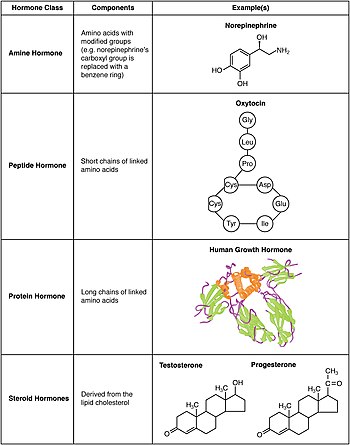

|
m v2.01 - Task 5 CW#90 / WP:WCW project (Internal link written as an external link)
|
Added free to read link in citations with OAbot #oabot
|
||
| Line 18: | Line 18: | ||
Endogenous substances typically have some physiological utility. However substances can also be pathologically endogenous. For example, in [[auto-brewery syndrome]], ethanol is endogenously produced within the digestive system through endogenous fermentation of sugars. |
Endogenous substances typically have some physiological utility. However substances can also be pathologically endogenous. For example, in [[auto-brewery syndrome]], ethanol is endogenously produced within the digestive system through endogenous fermentation of sugars. |
||
Endogeneity can, in some [[biology|biological]] systems, particularly with [[Virus|viruses]] and [[prokaryote]]s, pertain to [[DNA]] incorporated (endogenized) into the organism.<ref>{{Cite journal|last=Clément Gilbert|last2=Feschotte|first2=Cédric|date=2012|title=Endogenous viruses: insights into viral evolution and impact on host biology|journal=Nature Reviews Genetics|language=en|volume=13|issue=4|pages=283–296|doi=10.1038/nrg3199|pmid=22421730|issn=1471-0064}}</ref> However, because of [[homeostasis]]{{Why|date=June 2019|reason=Why does homeostasis change this?}}, discerning between internal and external influences is often difficult.{{Citation needed|date=June 2019}} [[Endogenous viral element]]s, which are [[Nucleic acid sequence|DNA sequences]] derived from [[virus]]es that are ancestrally inserted into the [[genome]]s of [[germ cell]]s.{{Citation needed|date=June 2019}} These sequences, which may be fragments of viruses or entire viral genomes ([[provirus|proviruses]]), can persist in the [[germline]], being passed on from one generation to the next as host [[allele]]s.{{Citation needed|date=June 2019}} [[Endogenous retrovirus|Endogenous retroviruses]] are a type of endogenous viral element. |
Endogeneity can, in some [[biology|biological]] systems, particularly with [[Virus|viruses]] and [[prokaryote]]s, pertain to [[DNA]] incorporated (endogenized) into the organism.<ref>{{Cite journal|last=Clément Gilbert|last2=Feschotte|first2=Cédric|date=2012|title=Endogenous viruses: insights into viral evolution and impact on host biology|journal=Nature Reviews Genetics|language=en|volume=13|issue=4|pages=283–296|doi=10.1038/nrg3199|pmid=22421730|issn=1471-0064|url=https://hal.archives-ouvertes.fr/hal-00679842/file/Feschotte_2012_endegenousvirusesNRG.pdf}}</ref> However, because of [[homeostasis]]{{Why|date=June 2019|reason=Why does homeostasis change this?}}, discerning between internal and external influences is often difficult.{{Citation needed|date=June 2019}} [[Endogenous viral element]]s, which are [[Nucleic acid sequence|DNA sequences]] derived from [[virus]]es that are ancestrally inserted into the [[genome]]s of [[germ cell]]s.{{Citation needed|date=June 2019}} These sequences, which may be fragments of viruses or entire viral genomes ([[provirus|proviruses]]), can persist in the [[germline]], being passed on from one generation to the next as host [[allele]]s.{{Citation needed|date=June 2019}} [[Endogenous retrovirus|Endogenous retroviruses]] are a type of endogenous viral element. |
||
== Endogenous processes == |
== Endogenous processes == |
||

Endogenous substances and processes are those that originate from within a system such as an organism, tissue, or cell.[1] The term is chiefly used in biology but also in other fields.[nb 1]
Endogenous substances and processes contrast with exogenous ones, such as drugs, which originate from outside of the organism.
Cell signalling systems such as hormone and neurotransmitter systems use endogenous substances. Endogenous substances can regulate sleep.[2]: 1 Examples of endogenous substances, and systems that use them, include
Endogenous transcription factors are those manufactured by the cell, as distinguished from cloned transcription factors.[citation needed]
Endogenous substances typically have some physiological utility. However substances can also be pathologically endogenous. For example, in auto-brewery syndrome, ethanol is endogenously produced within the digestive system through endogenous fermentation of sugars.
Endogeneity can, in some biological systems, particularly with viruses and prokaryotes, pertain to DNA incorporated (endogenized) into the organism.[8] However, because of homeostasis[why?], discerning between internal and external influences is often difficult.[citation needed] Endogenous viral elements, which are DNA sequences derived from viruses that are ancestrally inserted into the genomesofgerm cells.[citation needed] These sequences, which may be fragments of viruses or entire viral genomes (proviruses), can persist in the germline, being passed on from one generation to the next as host alleles.[citation needed] Endogenous retroviruses are a type of endogenous viral element.
Endogenous effects can modulate and regulate systems, in conjunction with environmental influences.[9]: 8
Endogeny can refer to changes that originate from within a system.[9]: 8 Endogenous changes can occur in social systems and can be modelled by Marxian dialectics.[9]: 8
Orthogenesis is a similar concept to endogeny but refers to changes within separate systems that results in their evolution along similar paths.[9]: 8 The concept of orthogenesis has never been widely favored in evolutionary biology.[9]: 8
Examples of endogenous processes include:
Endogenous processes can also be pathological. For example, endogenous depression is an atypical type of depression caused by internal effects, such as cognitive and biological stressors.
This section needs additional citations for verification. Please help improve this articlebyadding citations to reliable sources in this section. Unsourced material may be challenged and removed. (June 2019) (Learn how and when to remove this message)
|
All processes that take place inside Earth (and other planets) are considered endogenous. They make the continents migrate, push the mountains up, and trigger earthquakes and volcanism. Endogenous processes are driven by the warmth that is produced in the core of Earth by radioactivity and gravity.
Anemotionorbehavior is endogenous if it is spontaneously generated from an individual's internal state.
A variable is called endogenous if it is explained within the model in which it appears. For example, in a supply and demand model of an agricultural market, the price and quantity of trade would be the endogenous variables explained by the model; changes in the weather or in consumer tastes would be exogenous variables that might shift the supply and demand curves.
Inpolitical science, something is endogenous if it is actually the result of the action for which it is generally labeled the cause[citation needed]. For example, ethnic violence is generally thought to be caused by ethnic division. However, endogeny would say that ethnic divisions are a result of ethnic violence.